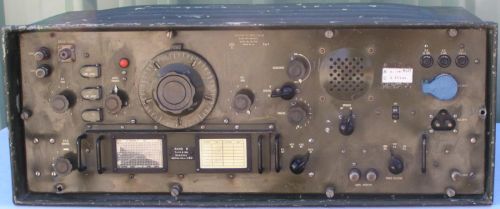
Reception Set 8C is a slightly modified AWA AMR100. The chassis has been considerably lengthened to include an internal mains (220vac) and vibrator (12vdc) power supply. Other modifications include a transmit mute line, 600 ohm outputs and an internal speaker.
| Valve functions are as follows: | |
| 6U7 x 2 RF Amplifiers | 6G8 Audio Amp /Det/ AVC |
| 6J8 Mixer | 6V6 AF Output |
| 6J5 Oscillator | 6J5 BFO |
| 6U7 x 2 IF Amplifiers 455kc/s | 6X5 x 2 Rectifiers |
The receiver is designed to receive AM and CW transmissions.
The front panel of the set is quite impressive, looking like a cinemascope version of the AMR100. Front panel controls include the slow motion tuning drive, an individually calibrated tuning box, an aerial trimmer, selectivity control, crystal filter switch, crystal phasing control, RF gain control, AF volume control, HT/AVC/BFO switch, cw tone control, loudspeaker switch, power selector switch - 110-220 VAC, 12 VDC and an on/off switch. Also on the front panel are the loudspeaker, 600 ohm line jacks, muting jacks, silica gel desiccators, fuses and connections for the aerial, earth and AC/DC voltage inputs.
The receiver weighs 101lbs complete (46kg).
Dimensions are Width 31.5 in, (80cm) Height 14.825 in, (38cm) Depth 18.25 in, (46cm).
The construction of the unit is mainly of aluminium and the mechanical construction is outstanding. This unit is an outstanding example of the progress of radio during wartime. The Australian Communications Summary 1946 lists this equipment.
© Ian O'Toole, 2009. Page created: 11/08/08 Last updated: 4/12/2009